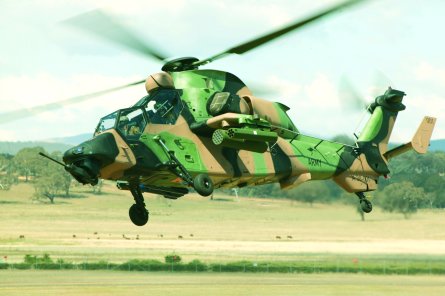By Peter La Franchi in London
Australia’s Tiger armed reconnaissance helicopter (ARH) programme is facing a potential serious overrun in through-life support costs, with prime contractor Australian Aerospace seeking major funding increases to meet contracted operational readiness targets.
A new review of the acquisition by the Australian National Audit Office (ANAO) reveals that Eurocopter subsidiary Australian Aerospace has sought increases worth A$365 million ($270 million) to existing through-life support contracts. The audit says that over the proposed 15-year initial service life of the aircraft, this would amount to a total additional cost of A$625 million.
|
The ANAO says the Tiger is failing to meet operational targets due to insufficient power from its MTR390 engines, and that Eurocopter is proposing an engine replacement programme to resolve the problem. Australia’s Defence Materiel Organisation (DMO) says this upgrade would require replacement of the entire aircraft drive train and could cost another A$100 million.
As at February 2006, the Australian army’s first six of 22 aircraft also continued to have problems with their radar navigation and altimeters, 30mm (1.2 inch) main guns, 70mm rockets, and aircraft mission management and electronic warfare mission support systems. The first Australian-assembled Tiger, aircraft five, was found in September 2005 to have additional deficiencies. “It took three test serials to bring the aircraft to a standard suitable for army acceptance and use,” the report says.
Capability delays have already seen the DMO seek liquidated damages worth A$258,000 from Australian Aerospace, while separate claims totalling A$10 million have also been lodged for late delivery of the aircraft training system.
The audit also reveals significant problems with the ARH project’s compliance to airworthiness regulations. Initial design work conducted during 2002 was carried out without Australian Aerospace holding authorised engineering organisation certification. Similarly, when aircraft five was accepted in June 2005 – nominally one month ahead of schedule – the DMO’s project office operational airworthiness authority delegation had expired five months earlier.
Discrepancies in payments made to Australian Aerospace for the acquisition phase have also been identified. The review confirms that some earned value payments were initially withheld by the DMO, but were then paid in October 2005 despite continued shortcomings in aircraft capability. The ANAO says Australian Aerospace’s push for through-life support increases was lodged with the DMO in September 2004 but was rejected in July 2005 “as being unjustified”.
However, the DMO has also invited Australian Aerospace to “provide a new proposal, which considered clarification of the objectives of the proposal; justification of the changes in the through-life support contract; identification of any increased staff requirements; increases in subcontractor costs; and an explanation of how existing through-life support plans might be affected”.
Source: Flight International
























